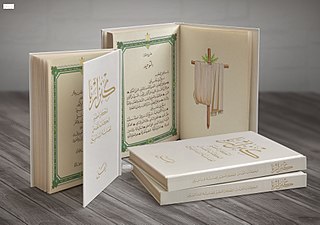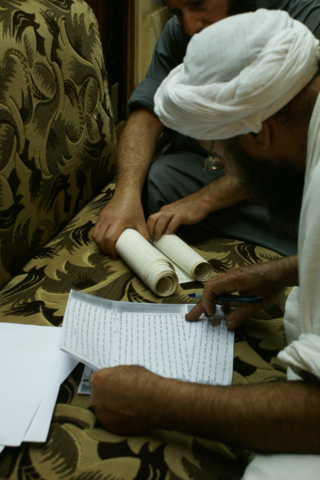
Mandaeism, sometimes also known as Nasoraeanism or Sabianism, is a Gnostic, monotheistic and ethnic religion with Greek, Iranian, and Jewish influences. Its adherents, the Mandaeans, revere Adam, Abel, Seth, Enos, Noah, Shem, Aram, and especially John the Baptist. Mandaeans consider Adam, Seth, Noah, Shem and John the Baptist prophets, with Adam being the founder of the religion and John being the greatest and final prophet.

The Qulasta, also spelled Qolastā in older sources, is a compilation of Mandaean prayers. The Mandaic word qolastā means "collection".
In Mandaeism, manda is the concept of gnosis or spiritual knowledge. Mandaeans stress salvation of the soul through secret knowledge (gnosis) of its divine origin. Mandaeism "provides knowledge of whence we have come and whither we are going."
The Haran Gawaita also known as the Scroll of Great Revelation, is a Mandaean text which recounts the history of the Mandaeans as Nasoraeans from Jerusalem and their arrival in a region described as "Inner Harran which is called the mountains of Madday", which some scholars have identified with Media. The Haran Gawaita continues the historical narrative of the Mandaean Book of Kings, adding a new eighth age to the seven described in that work.
In Mandaeism, Rūha is the queen of the World of Darkness or underworld. She rules the underworld together with her son Ur, the king of the World of Darkness, and her entourage of the seven planets and twelve constellations, who are also her offspring with Ur.
In Mandaeism, Ptahil also known as Ptahil-Uthra, is the Fourth Life, the third of three emanations from the First Life, Hayyi Rabbi, after Yushamin and Abatur. Ptahil-Uthra alone does not constitute the demiurge but only fills that role since he is viewed as the creator of the material world in the Ginza Rabba, often holding an inherently malicious character.
In Mandaeism, Yushamin and also known as the 'Second Life', is the primal uthra and a subservient emanation who was created by the Mandaean God 'The Great Life', hence beginning the creation of the material world. Yushamin is the father of Abatur. Jorunn J. Buckley identifies Yushamin as "both a Lightworld utra beyond reproach and the prototype of a priest who has made mistakes in ritual."
In Mandaeism, Manda d-Hayyi or Manda ḏ-Hiia is an uthra sent by the Great Life as a messenger to John the Baptist. Manda d-Hayyi is considered to be the most important uthra, since he is the one bringing manda to Earth (Tibil).
In Mandaeism, Hayyi Rabbi, 'The Great Living God', is the supreme God from which all things emanate.

Maṣbuta is the ritual of immersion in water in the Mandaean religion.
The Baptism of Hibil Ziwa or Diwan Maṣbuta ḏ-Hibil Ziwa is a Mandaean illustrated scroll. It describes the soteriological descent of Hibil Ziwa to the World of Darkness, and his baptisms before and after. The scroll is essentially also a commentary on the masbuta, or Mandaean ritual baptism.
In Mandaeism, Hibil or Hibil Ziwa is an uthra from the World of Light. Hibil is considered to be the Mandaean equivalent of Abel.

The Coronation of the Great Šišlam is a Mandaean religious text. The text is a detailed commentary on the initiation of the tarmida, with detailed discussions on masbuta and masiqta rituals. The Scroll of Exalted Kingship is also used extensively alongside the Coronation in tarmida initiation rituals. Similar esoteric texts that are traditionally used exclusively by Mandaean priests include The Thousand and Twelve Questions, and The Baptism of Hibil Ziwa.
In Mandaeism, the pihta is a type of sacramental bread used with rituals performed by Mandaean priests. It is a small, round, biscuit-sized flatbread that can either be salted or saltless, depending on whether the ritual use of the pihta is for living or dead people.

The drabsha or darfash is the symbol of the Mandaean faith. It is typically translated as 'banner'.

In Mandaeism, the klila is a small myrtle wreath or ring used during Mandaean religious rituals. The klila is a female symbol that complements the taga, a white crown which always takes on masculine symbolism.

In Mandaeism, the taga is a white crown traditionally made of silk that is used during Mandaean religious rituals. The taga is a white crown which always takes on masculine symbolism, while the klila is a feminine symbol that complements the taga.
In Mandaeism, Yawar Ziwa is an uthra from the World of Light. He is the personification of light.
In Mandaeism, misha is anointing sesame oil used during rituals such as the masbuta (baptism) and masiqta, both of which are performed by Mandaean priests.
The following outline is provided as an overview of and topical guide to Mandaeism.








